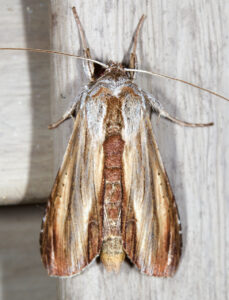By Edie Parnum
Yes, of course. I was thrilled to discover a brown-hooded owlet in my late October garden. This caterpillar with its glossy yellow, red, blue, and black pattern is beautiful. It is pre-frost as I write, so the leaves of the aster where it’s feeding are still green and evidently tasty.
For three days I’ve watched it feeding and pooping. Thankfully, the nearby hungry birds have not spotted it. Frost is coming, so I hope it will soon crawl down the aster plant where it has been feeding and make its pupa. As a caterpillar this insect won’t live through the winter, but its pupa can survive unseen in the soil or decaying leaf litter. In the spring after undergoing metamorphosis, a drab brown one-inch adult moth will

Brown-hooded Owlet adult, an excellent pollinator. Photo credit: Jim Petranka and Becky Elkin; dpr.ncparks.gov. Click to enlarge.
emerge. This night-flying moth will visit flowers for their nectar and spread the pollen to fertilize other plants. Then it will mate and lay eggs on asters and goldenrods that will hatch into these caterpillars. To complete its entire life cycle, my caterpillar needs humus-rich soil, native asters and goldenrods, and nectar-rich perennial flowers.
The brown-hooded owlet is my favorite caterpillar. I wish more people had favorite caterpillars. They are essential bird food and as adults become excellent pollinators. In the case of the brown-hooded owlet caterpillars, they require native asters and goldenrods as their host plants.
We need beautiful caterpillars and drab ones, too. Without them birds will suffer, plants (including our food plants) will be less plentiful, and our lives less rich. Let’s plant more host plants and leave decaying leaf litter for the caterpillars.

